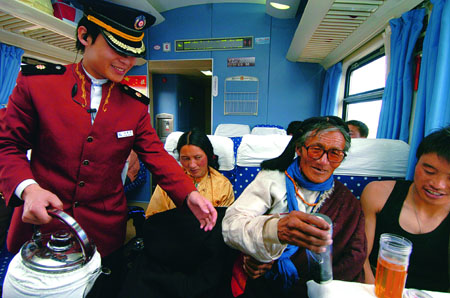| Since its successful trial run on July 1, 2006, the Qinghai-Tibet Railway has served as an economical and high-speed transportation passage on the Qinghai-Tibet Plateau, greatly reducing the cost of regional economic development. By the end of June 2007, it had transported about 2.02 million passengers. In the 10 months ending April 30, 2007, the value of Tibet's overseas trade reached US$322 million, an increase of 75.5 percent over the same period of the previous year. By early June 2007, the railway workers had treated some 60,000 tons of sewages in a concentrated way, and no case of environmental pollution occurred over the year. After the successful trial run of the railway, Tibet succeeded in introducing 4 billion Yuan of investment in a six-month period, and the in-paid capital rate reached 45 percent, as against 33 percent in the past.
Since the successful trial run of the Qinghai-Tibet Railway, the number of pilgrims in the region hit a historical high. The Potala Palace, Norbu Lingka and Jokhang Monasery in Lhasa received 328,000 people, an increase of 62,000 from the previous year. At a press conference held by the State Council Information Office on June 29, Shapa Puncog, Chairman of the People's Government of the Tibet Autonomous Region, said the Qinghai-Tibet Railway greatly promoted the development of Tibet's tourism and social progress. He said that a series of measures have been taken to effectively protect the ecological environment.

The Qinghai-Tibet Railway makes it easier for the Tibetans to travel afar. Picture shows Tibetan old people from Yushu of Qinghai Province, who go to Lhasa for pilgrimage, receive good service in the train.
The latest monitoring results along the railway showed that through one year's operation, the equipment, personnel and management of the Qinghai-Tibet Railway realized safe, stable and orderly operation.
The Lhasa-Xigaze Railway, the planned extension of the Qinghai-Tibet Railway, is under geological prospecting and route selection and is expected to be completed in 2010. It has a total length of 254 km, with a preliminary budgeted investment of 11 billion Yuan. Preliminary planning has begun for the Lhasa-Nyingchi Railway, which is expected to be constructed in five years. This will then form a Sichuan-Yunnan-Tibet Railway, driving the economic and trade development between the western provinces such as Qinghai, Gansu, Sichuan, Yunnan and Xinjiang and South Asia. |





